Haematophobia, also known as blood phobia, is an intense and irrational fear of blood. This phobia can be distressing, and individuals with haematophobia may go to great lengths to avoid situations involving blood. Here’s an overview of haematophobia, including its causes and treatment options:
Causes of Haematophobia:
The exact causes of haematophobia can vary from person to person, but several factors may contribute to its development, including:
- Past Traumatic Experience: A traumatic event involving blood, such as witnessing an accident or injury, can lead to a fear of blood.

- Genetic Predisposition: Some individuals may have a genetic predisposition to anxiety disorders, including phobias like haematophobia, if there’s a family history of anxiety.
- Learned Behavior: Children may develop haematophobia if they observe fearful reactions to blood from family members or caregivers.
- Media Exposure: Excessive exposure to graphic or disturbing images of blood in the media can sensitize individuals to the fear of blood.
Symptoms of Haematophobia:
Haematophobia can trigger various physical, emotional, and behavioral symptoms, including:
- Panic Attacks: The sight or thought of blood can lead to panic attacks or severe anxiety.
- Avoidance Behaviors: Individuals with haematophobia may avoid situations that could expose them to blood, such as medical procedures, accidents, or even discussions about blood.
- Physical Symptoms: Anxiety-related physical symptoms may include rapid heartbeat, sweating, trembling, nausea, shortness of breath, and a strong desire to flee the situation.
- Negative Thoughts: Persistent negative thoughts about blood or injuries may dominate the individual’s thinking.
Treatment Options for Haematophobia:
Haematophobia can be effectively treated with various therapeutic approaches. Here are some common treatment options:
- Cognitive-Behavioral Therapy (CBT): CBT helps individuals identify and challenge irrational thoughts and beliefs related to their fear of blood. It aims to change unhealthy attitudes and behaviors.
- Exposure Therapy: Gradual and controlled exposure to blood-related situations or discussions can help desensitize individuals to their fear. This therapy is often conducted under the guidance of a therapist.
- Systematic Desensitization: This therapeutic approach involves a step-by-step process of gradually exposing the individual to increasingly anxiety-provoking situations involving blood while teaching relaxation techniques to manage anxiety.
- Medication: In some cases, healthcare providers may prescribe anti-anxiety medications to manage the symptoms of anxiety or panic attacks associated with haematophobia. Medication is typically used in conjunction with therapy and should be discussed with a healthcare professional.
- Education: Learning about the human body, blood, and the safety measures in place during medical procedures can help individuals better understand and manage their fear.
- Support Groups: Joining a support group for individuals with haematophobia can provide a safe space to share experiences, learn coping strategies, and receive emotional support.
Seeking help from a qualified therapist or healthcare professional is crucial for individuals with haematophobia. With the right treatment and support, individuals can learn to manage their fear of blood, which can significantly improve their quality of life and reduce anxiety in situations involving blood.











